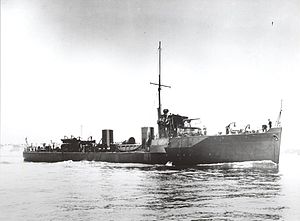HMS Eden was a Hawthorn Leslie type River-class destroyer ordered by the Royal Navy under the 1901 – 1902 Naval Estimates. Named after the River Eden in northern England, she was the second ship to carry this name since it was introduced in 1814.
 HMS Eden in 1909.
| |
| History | |
|---|---|
| Name | HMS Eden |
| Ordered | 1901 – 1902 Naval Estimates |
| Builder | R.W. Hawthorn Leslie and Company, Ltd, Newcastle-upon-Tyne |
| Laid down | 12 June 1902 |
| Launched | 13 March 1903 |
| Commissioned | June 1904 |
| Fate | Lost in collision, 18 June 1916 |
| General characteristics | |
| Class and type | Hawthorn Leslie type River-class destroyer[1][2] |
| Displacement |
|
| Installed power | 7,000 shp (5,200 kW) (average) |
| Propulsion |
|
| Speed | 25.5 kn (47.2 km/h) |
| Range |
|
| Complement | 70 officers and men |
| Armament |
|
| Service record | |
| Part of: |
|
| Operations: | World War I 1914 - 1918 |
Construction
editShe was laid down on 12 June 1902 at the Hawthorn Leslie shipyard at Hebburn-on-Tyne and launched on 13 March 1903. She was completed in June 1904. She differed from the other boats of the class by having Parsons turbines instead of reciprocating steam engines. On her trials she made 26.2 knots (48.5 km/h; 30.2 mph), and was the fastest boat of the class. Her original armament was to be the same as the turtleback torpedo boat destroyers that preceded her. In 1906 the Admiralty decided to upgrade the armament by landing the five 6-pounder naval guns and shipping three 12-pounder 8 hundredweight (cwt) guns. Two would be mounted abeam at the fo'clse break and the third gun would be mounted on the quarterdeck.
Pre war
editAfter commissioning she was assigned to the East Coast Destroyer Flotilla of the 1st Fleet and based at Harwich. She was used for a lot of test runs with her conventionally-powered sister Waveney to ascertain whether her turbines represented an improvement.
In April 1909 she was assigned to the 3rd Destroyer Flotilla on its formation at Harwich. She remained until displaced by a Basilisk-class destroyer by May 1912. She was assigned to the 5th Destroyer Flotilla of the 2nd Fleet with a nucleus crew.
In the early morning of 28 January 1910 while under the command of Lieutenant Oliver M F Stokes she broke loose from her moorings in bad weather and sank at the Harbour Jetty under the East Cliff at Dover. She was refloated on 30 January and repaired.
On 30 August 1912 the Admiralty directed all destroyer classes were to be designated by alpha characters starting with the letter 'A'. The ships of the River class were assigned to the E class. After 30 September 1913, she was known as an E-class destroyer and had the letter ‘E’ painted on the hull below the bridge area and on either the fore or aft funnel.[3]
World War I
editIn early 1914 when displaced by G-class destroyers she joined the 9th Destroyer Flotilla based at Chatham tendered to HMS St George. The 9th Flotilla was a patrol flotilla tasked with anti-submarine and counter mining patrols in the Firth of Forth area. By September 1914, she was deployed to the Dover Patrol based at Portsmouth. Here she provided anti-submarine, counter mining patrols and defended the Dover Barrage.[4]
Loss
editOn the night of 18 June 1916 HMS Eden collided with the transport SS France in the English Channel. She sank with the loss of her commander, Lieutenant A C N Farquhar and 42 officers and men. The damaged transport rescued 33 officers and men.[5] Today, her wreck lies in 34 m (112 ft) in the waters near Fécamp.[6]
Pennant numbers
edit| Pennant number[7] | From | To |
|---|---|---|
| N42 | 6 December 1914 | 1 September 1915 |
| D17 | 1 September 1915 | 18 June 1916 |
References
edit- ^ Jane, Fred T. (1969) [1905]. Jane's Fighting Ships 1905/6. New York: first published by Sampson Low Marston, London 1905, reprinted by ARCO Publishing Company. p. 75.
- ^ Jane, Fred T. (1990) [1919]. Jane's Fighting Ships of World War I. Jane’s Publishing. p. 76. ISBN 1-85170-378-0.
- ^ Conway's All the World's Fighting Ships 1906 to 1922. Conway Maritime Press. 2006. pp. 17–19. ISBN 0-85177-245-5.
- ^ "Naval Database". Archived from the original on 22 February 2014. Retrieved 19 June 2013.
- ^ "WWI British Destroyers at Naval-History.net". Retrieved 3 February 2009.
- ^ "Fécamp at Channel Diving". Archived from the original on 9 July 2009. Retrieved 3 February 2009.
- ^ ""Arrowsmith" List: Royal Navy WWI Destroyer Pendant Numbers". Retrieved 3 February 2009.
Bibliography
edit- Chesneau, Roger & Kolesnik, Eugene M., eds. (1979). Conway's All The World's Fighting Ships 1860–1905. London: Conway Maritime Press. ISBN 0-85177-133-5.
- Colledge, J. J.; Warlow, Ben (2006) [1969]. Ships of the Royal Navy: The Complete Record of all Fighting Ships of the Royal Navy (Rev. ed.). London: Chatham Publishing. ISBN 978-1-86176-281-8.
- Dittmar, F.J.; Colledge, J. J. (1972). British Warships 1914–1919. Shepperton, UK: Ian Allan. ISBN 0-7110-0380-7.
- Friedman, Norman (2009). British Destroyers: From Earliest Days to the Second World War. Barnsley, UK: Seaforth Publishing. ISBN 978-1-84832-049-9.
- Gardiner, Robert & Gray, Randal, eds. (1985). Conway's All The World's Fighting Ships 1906–1921. London: Conway Maritime Press. ISBN 0-85177-245-5.
- Manning, T. D. (1961). The British Destroyer. London: Putnam & Co. OCLC 6470051.
- March, Edgar J. (1966). British Destroyers: A History of Development, 1892–1953; Drawn by Admiralty Permission From Official Records & Returns, Ships' Covers & Building Plans. London: Seeley Service. OCLC 164893555.